Over the last decade or so, I’ve tried a bunch of diet tracking apps with very little, if any, success — still carrying my extra 20 lb around. That may be my laziness, or perhaps those nutrition apps failed miserably.
Ok, it may be both. Still, one might wonder, “How to make a nutrition app that guarantees long-lasting positive results?” How do you ensure that your diet and nutrition app development efforts gain more user reviews like these:
 and less of those:
and less of those:

Let’s find out together!
Top Takeaways
- By 2027, the diet tracking and nutrition apps market is expected to surpass $10,189.62 million. That’s precisely why investing in diet app development today makes a lot of sense.
- Best-performing nutrition applications include a combination of features besides calorie counting that lead to behavior changes.
- To develop a nutrition application that really stands out, consider integrating it with various accompanying services, e.g., food delivery or dietitian consulting.
Table of Contents
Diet and Nutrition Apps Market Overview
Types of Nutrition and Diet Apps
Key Features of Diet and Nutrition Apps
How Do Diet and Nutrition Apps Make Money?
Tech Stack to Develop a Diet App
5 Steps to Make a Nutrition App
How Much Does it Cost to Build a Diet and Nutrition App?
Our Experience in Developing Nutrition and Diet Apps
Diet and Nutrition Apps Market Overview
As more and more people realize that healthy eating is a critical part of living a happy, healthy life, the market of nutrition mobile apps keeps steadily growing. Research shows that the diet and nutrition apps market may reach $10,189.62 million by 2027.
In fact, it’s already a pretty thriving market. If we go to a mobile intelligence platform like SensorTower and check the top 10 diet and nutrition applications, we’ll discover that they generate:
- close to 2 million downloads per month
- a little over $13.5 million in revenue per month
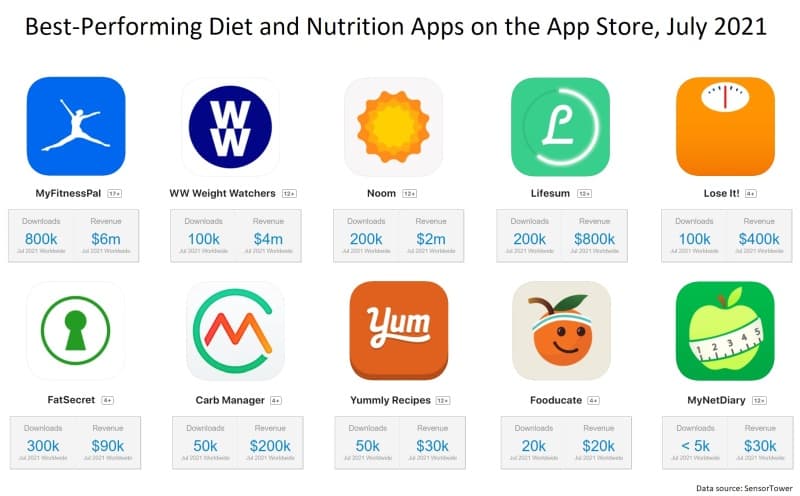
Types of Nutrition and Diet Apps
When it comes to diet tracker app development, there are several routes you can choose from in terms of functionality. There are all sorts of nutrition and diet mobile solutions with different features out there.
Calorie counter apps
Mobile solutions like Lose It and Lifesum mainly focus on helping users count consumed calories. Besides the calorie-counting feature, such applications often provide additional insights into the nutrient quality of different foods by analyzing ingredients.
Related: How to Build a Calorie Counter App like MyFitness Pal
Recipe applications
With recipe apps, users get to choose the best meals according to their food preferences and health and fitness goals. The main premise of these mobile products is to educate users on how to cook healthy meals.
Examples: Paprika, PlateJoy
Niche diet tracking apps
People with specific tastes or dietary preferences may benefit from referencing a diet tracking mobile solution. So if a user is vegetarian, suffers from diabetes, or bears a child — they can sort foods based on their individual circumstances.
Related: Diabetes Management App Development
Examples: HappyCow, Bump
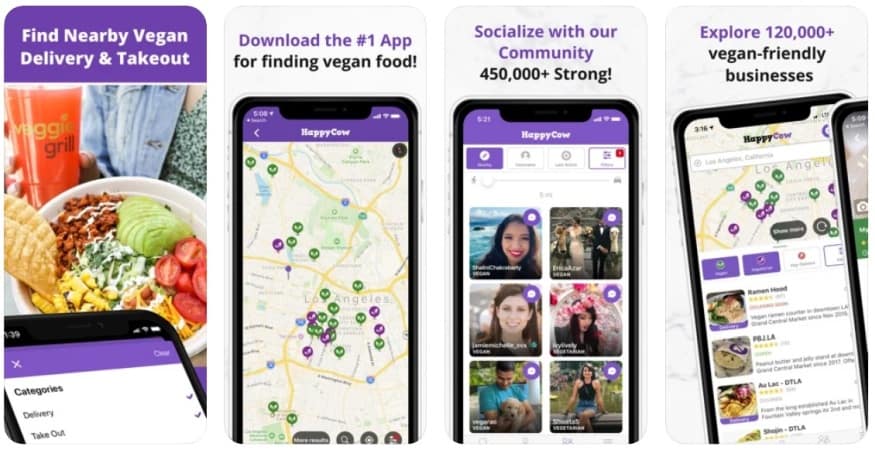
Fitness-focused applications
Some nutrition apps pivot strongly into tracking physical activity and exercises. Partly because healthy eating implies tracking not only consumed calories but spent ones too. Partly because having fitness lessons balanced against users’ eating habits in one product is super convenient.
By the way, we’ve discussed how to build a fitness tracker app in a separate blog.
Examples: Argus, SparkPeople
Wager apps
Other diet tracking applications get wildly popular because of a game theory backing them. Such applications allow users to bet on reaching their weight goals within a set period. Of course, such a gamified approach aims to give them more incentive to follow through on promises.
Examples: DietBet, Healthy Wage
Then, generalist diet tracking and nutrition apps like MyFitnessPal (learn how to build a calorie counter app like MyFitnessPal here) and FatSecret combine most of these features in a single mobile product. The trick here is to onboard customers looking for a particular use case and then engage them with the rest of the features.
Key Features of Diet and Nutrition Apps
Before you go and make a diet app, let’s discuss the features a typical nutrition application should have. It goes without saying that you will need a killer feature, offering great value to customers if you want to develop a nutrition application that eventually becomes successful.
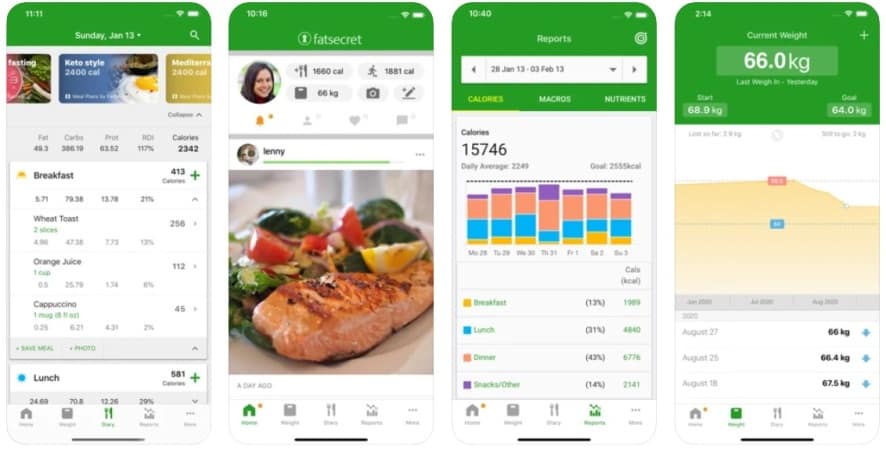
The cherry-on-top functionality may have to do with augmented reality or integration with a novel smart device. Still, there’s a default set of features that users will expect from your product.
Registration
Onboarding must be as smooth as possible. I’d recommend Apple ID, Facebook, or Google Account because people already know how they work, and the user experience is super simple.
Ideally, you’d let users right into the application without any registration at all. Try offering to register when the user tries to access some advanced features, e.g., charts or when they’ve entered a certain number of entries.
Tips:
- explain why you need users to create accounts and what benefits they will gain
- save entered data even if the user exits the app before creating an account
Goals
Nutrition application development should absolutely include user goals. After all, how can you create a successful diet app if you don’t know what your customers are trying to achieve? Typical objectives include: losing and keeping weight, sticking to a specific diet, etc.
Tips:
- allow users to submit a custom goal besides choosing from preset options
- update your product with more goals after you’ve learned them from existing users
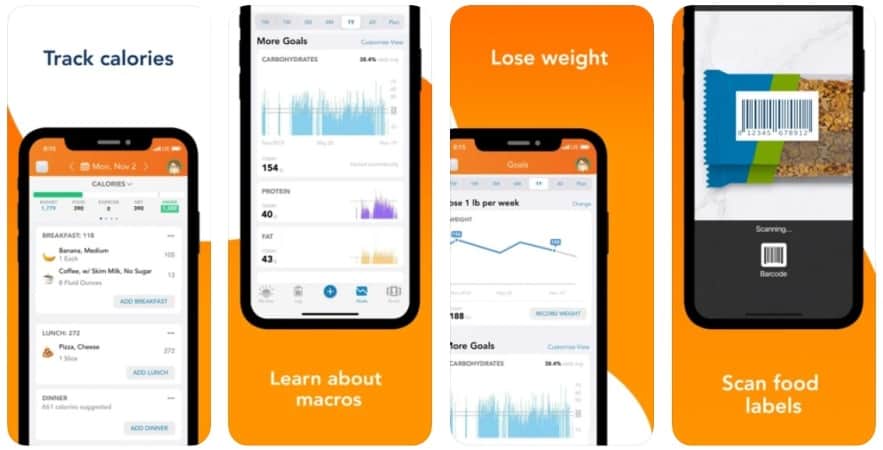
Nutrition data input
This option is the heart and soul of your solution. If people can’t quickly enter a meal, they will hardly stick around the app for long. That’s why planning and designing the input screen with a calorie calculator is so critical to the whole project’s success.
Tips:
- have recent and favorites ready
- integrate a barcode scanner
- integrate with comprehensive food databases
Calorie tracking dashboard
Reports displaying users’ progress is the only reason they input any data into your mobile product.
Therefore, it behooves any app owner to create a comprehensive dashboard that is intuitive and not overwhelming at the same time.
Tips:
- separate different metrics into individual dashboards
- introduce a central metric like a health score, which would calculate based on other metrics
Related: How to create a dashboard web app
Meal planning
How to develop a diet app that urges users to change their eating habits? Remember to include meal planning functionality because as users turn to savvy eaters, they want more healthy food choices.
Tips:
- include versatile recipes with ingredient breakdown
- allow planning for a week ahead
Social features
It’s hard to deny that any application featuring user-generated content keeps evolving faster than the competition.
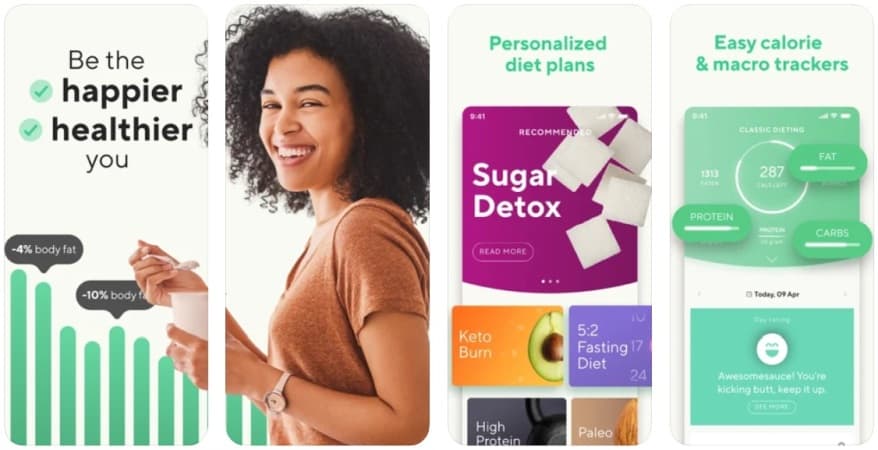
So why skip this opportunity? People love bragging about their changing lifestyles and weight loss achievements. Social sharing can turn the whole process into a game where friends compete against each other.
Tips:
- envision an inclusive ranking system where each user gets some recognition
- Include virtual awards, badges, and stickers so customers can manifest their achievements
Notifications
Finally, your mobile product will need to nudge some users to stick to the plan and enter their data. Ideally, you could have a dedicated section in settings where users can set their notification preferences (e-mail or push notifications) for different in-app events.
Tips:
- allow granular control over different types of notifications
- customize notifications to take users to appropriate screens
How Do Diet and Nutrition Apps Make Money?
I bet any founder envisioning a diet and nutrition app asks questions like, “How to create a diet app that actually makes money?” Well, these applications use the same monetization options found in other mobile products:
- Subscription
- In-app purchases
- Paid apps
Apple and the software industry, in general, bet on the subscription model. So why reinvent the wheel? Define the feature set that brings the most value and offer them through tiered subscriptions.
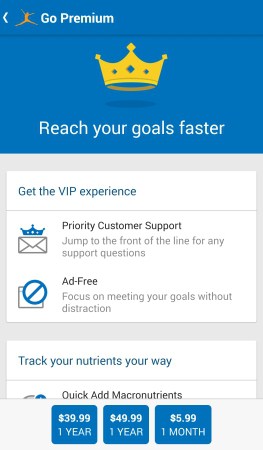
Tech Stack to Develop a Diet App
When you build a nutrition application, it’s tough to screw it up tech-wise. You can go with native development and use Kotlin or Java for Android and Swift for iOS. However, you can also use cross-platform tools like React Native or Flutter.
Related: How to choose the right tech stack for your app
In fact, going with React Native, Flutter, or a similar tool may be the best option since you’ll be able to ship both iOS and Android applications to the market faster, on a smaller budget.
In addition, React Native or Flutter code can be reused for making a web application to accompany the mobile solution if you feel like customers can benefit from using the product on desktops. So if you’re wondering how to create a nutrition app on a lean budget, the cross-platform approach is a legit way out.
If you check the most successful diet and nutrition application on https://stackshare.io/, you’ll notice they are using both Objective-C, Swift, and C. No Kotlin or Java, which tells us they are gradually rewriting the product for iOS, using the native (aka Swift) stack.
Related
- React Native vs PWA: The Better Choice?
- React Native vs Swift: What does your Mobile App need?
- React Native vs Flutter: The Guide for App Owners
5 Steps to Make a Nutrition App
Let’s discuss the actual steps you need to take during diet app development. Here’s a quick overview of the process:
| Step | Description | Key Actions |
|---|---|---|
| Step 1: Prototyping | Create a clickable prototype to test with users and developers. | Validate the concept with usertesting.com and gather developer feedback to ensure feasibility before coding. |
| Step 2: Development | Develop the app’s backend, integrations, and core functionality. | Build backend systems, integrate third-party tools, consider HIPAA compliance (if needed), and explore AI and smartwatch features. |
| Step 3: Testing | Thoroughly test the app across devices and scenarios. | Run manual and automated tests on various devices and delegate to QA professionals for comprehensive error detection. |
| Step 4: Release | Launch the app and go live. | Get approval from app stores, switch to a live server, and begin marketing efforts. |
| Step 5: Maintenance | Track user behavior and continuously improve the app. | Monitor metrics, plan updates, and address bugs with error-tracking tools like Sentry. |
Step 1: Prototyping
The most natural way to build a diet and nutrition app is to start with an interactive prototype. What’s a prototype? A click-through version of your product that exists purely in design, with zero coding involved.
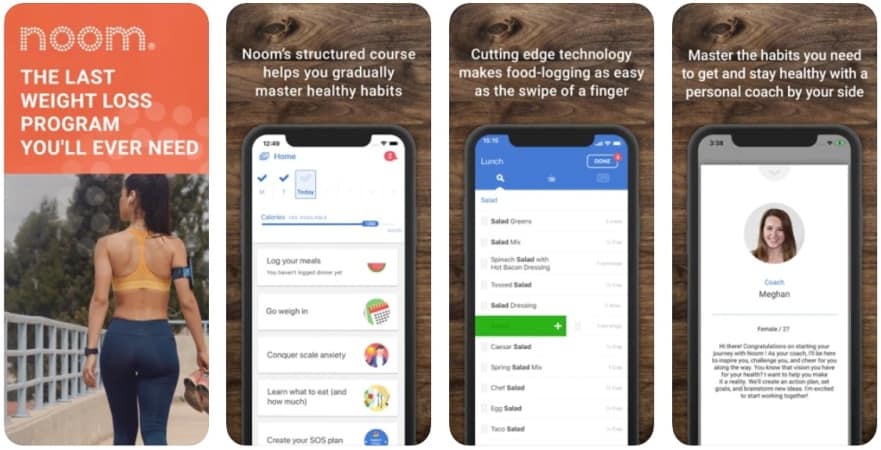 Prototyping is great because you can run it through usertesting.com or similar services to find out if the application resonates with your target audience before you start coding it.
Prototyping is great because you can run it through usertesting.com or similar services to find out if the application resonates with your target audience before you start coding it.
Another benefit is getting developers’ feedback during the prototyping phase to verify that the design is feasible and to find compromises (if needed) before coding begins. Because development is the most expensive part of any project, and diet creating app is no exception.
Step 2: Development
That’s obviously where the biggest chunk of work happens. Although this step may also seem the most tedious to you as an app owner, here are a few points you should consider when custom developing an app:
Back end development
If you’ve read our previous blogs, you already know that any mobile solution has a back end. That’s where a database, logic, APIs, and other behind-the-scenes stuff resides.
However, your back end may also include an admin portal where you can manage your app’s content. Some of the things you might want to see in such an admin portal include:
- user management (block/unblock offensive content)
- articles and educational content
- Notifications management
Integrations
For your diet tracking and nutrition application to bring real value to users, it needs to integrate with third-party services, smart devices, and native mobile OS features.
Pulling data from connected scales and various activity trackers helps customers get a comprehensive picture of calorie expenditure. To enable these IoT capabilities in your product, you will need to use the BLE (Bluetooth low energy) technology.
In terms of tapping into native mobile OS functionality, a nutrition application may benefit from using:
- HealthKit (iOS), Google Fit (Android), and Samsung Health
- Siri shortcuts or Google Assistant integrations for quick data input
- Widgets for displaying critical information
As for utilizing third-party services, some interesting options may include integration with food delivery services and directory listing services like Yelp. One other idea is to integrate with a fitness application and show workouts that help users burn the desired amount of calories.
Read more on AI-fitness app development
HIPAA compliance
Fortunately, you don’t need to worry about HIPAA compliance during nutrition app development as long as your app does not track users’ vitals like heart rate, oxygen level, etc.
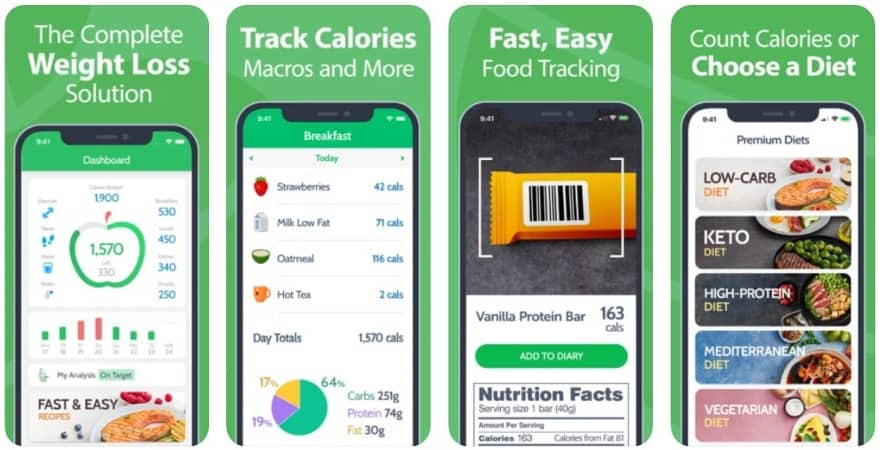 Otherwise, implement these best practices for the solution to comply with the HIPAA rules:
Otherwise, implement these best practices for the solution to comply with the HIPAA rules:
- enable HTTPS for data transfers
- encrypt all data in transit and at rest
- comply with ISO27001, SOC2 Type 2, and IEC 62304
- use biometric authentication (Touch ID or Face ID)
- include two-factor authentication
Related: HIPAA Compliant App Development: The Complete Guide
Artificial intelligence
You may also upgrade your diet tracking app with AI capabilities. Wouldn’t it be nice if machine learning algorithms could help visualize personalized user progress into the future based on their current behavior registered in your product? Or if there was an intelligent assistant offering advice on how consumers can change their eating habits to get better results?
Related: How to Develop a Machine Learning App: The Whys and Hows
Smartwatch companion
I noticed that some of the most advanced nutrition applications also offer a smartwatch companion app or even a standalone solution that works on Apple Watch and Android Wear devices.
What are the advantages? Accurate tracking of user movements and health metrics, at-a-glance reminders, and quick data entry, to name just a few.
Related: How to Build a Wearable App for Android wear OS and Apple Watch OS
Real-time communications
Your mobile software may become a platform for connecting people with nutritionists and dietitians. In that case, you’d need to include a live chat and/or video calling into the app.
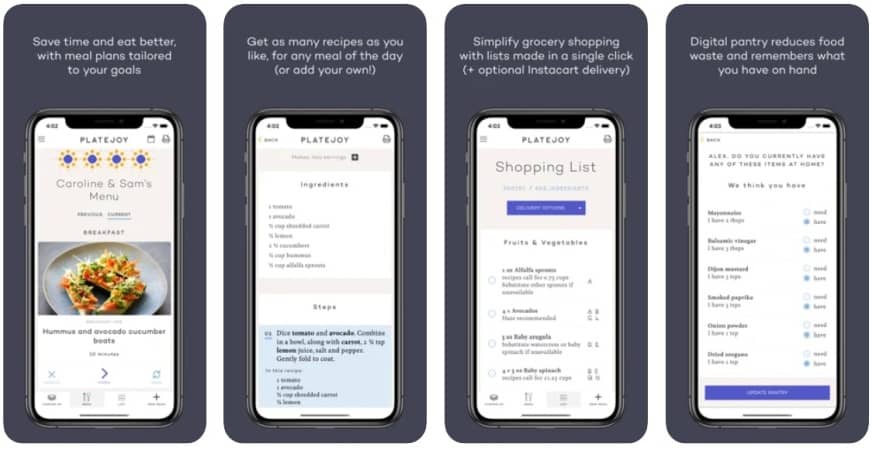
Step 3: Testing
As much as we love working with glitch-free software, testing it is an absolute nightmare. No, really. Imagine all the devices your application needs to support: all the screen sizes, OS versions and flavors. Think about all the possible what-if scenarios for people to interact with the app. It’s just mind-boggling.
That’s why you need to delegate this to professionals. They know how to run all sorts of tests, including manual and automated tests, which help catch errors even during development. They have access to special platforms for testing your mobile app on a variety of devices at once. In short, a team that takes QA seriously always ships better products than anybody else and saves you a ton of time.
Related: The Complete Guide to Testing Your App: Best Practices, Features, Tools, and more
Step 4: Release
The most exciting thing — getting your apps approved for the App Store and Google Play. Plus, you’ll need to switch your server to a live environment, which you presumably have stress-tested at the previous step.
Voila, your product becomes available to customers, and you can start marketing it!
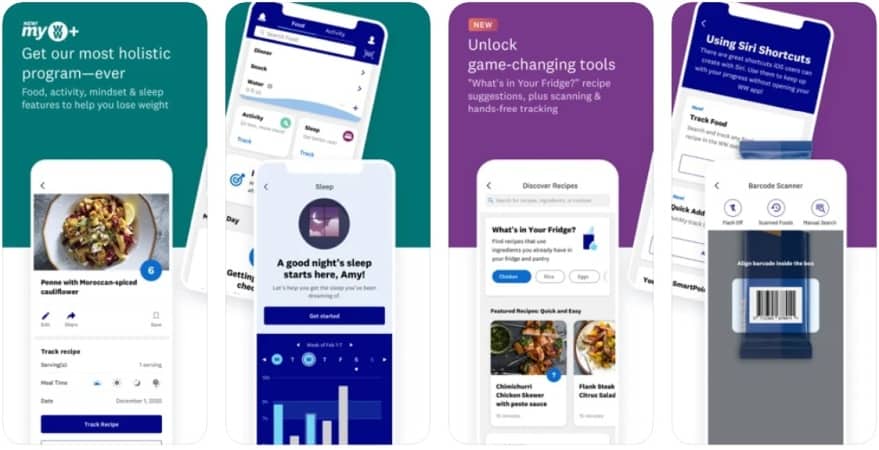
Step 5: Maintenance
After releasing your app to the public, you will need to track quite a few things:
- Where are users coming from?
- Are there any issues in the app that harm the user experience?
- How many users stick with the application?
That’s actually just the tip of the iceberg. Check out our DIY Guide to Tracking Mobile App Metrics for more information.
Apart from tracking app metrics, you also need to plan for future features and updates to support the newest iOS and Android features.
Finally, bugs. Those are unavoidable. Even after the most rigorous testing, you’re bound to run into weird rare issues on some devices. Therefore, having a service like Sentry that can automatically track errors and pinpoint the problematic areas in the product is essential to your app’s success.
How Much Does it Cost to Build a Diet and Nutrition App?
The cost will totally depend on the app’s features. I think it’s safe to say that an MDP (minimum delightful product) version of a nutrition application may cost you around $46,000, and a fully-featured app will round up at $80,000.
Our Experience in Developing Nutrition and Diet Apps
One of the most exciting mobile products we’ve recently developed is a Tula Health mobile app that helps people monitor and track their blood sugar history and trends. The application includes a healthy eating section that educates users about a sugar-balanced diet and recommends appropriate meals and recipes.
We also worked on a Kitchen Wizard app that allows users to pick certain dietary restrictions and then see appropriate food recipes and ingredients that fit those goals. After we redesigned the app and created a scalable solution, the product could quickly scale from 500 recipes to 70k recipes, and user retention increased from 2% to 10%. Read the case study for more details.
Here’s also an exciting case study about how you can develop a habit-tracking fitness app. It’s a progressive web app (optimized for mobile) we built for a CrossFit studio.
Related Articles:
- How to build a fitness application
- Pose Estimation Guide
- How to create a telehealth application
- Build or buy a telehealth solution: Making the Better Choice
Frequently Asked Questions
Are there some legit shortcuts to ship a diet tracking app faster?
Yes, cross-platform development approach and use of stock iOS or Android features, e.g., integration with the default calendar app for a planner feature, etc.
I'm struggling with a killer feature for my diet tracking application. Do you have any ideas?
Look at apps like Sweatcoin and think about game theories that can go into a mobile app powered by cryptocurrency that incentivizes people to eat healthy food.
Won't my diet application turn into a fitness solution if I add workouts?
It depends on how well you tie in workouts with the nutrition features of your product. By the way, you can glean many details about how you can create a fitness app in our other blog.
How long does it take to develop a nutrition application?
Between 4 and 6 months. An MVP can be built within a 30-month time frame.

